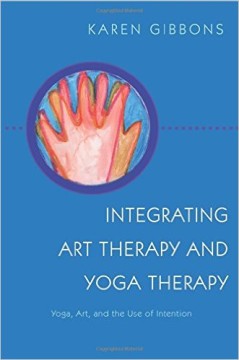
Read about new research on the anti-inflammatory effects of yoga practice and a study about how the brain responds to meditation. We gather the latest studies on yoga and mental health as well as reviews of new books—one beautiful enough to grace your coffee table by master yoga therapist and Ayurvedic clinician Indu Aurora, and another to keep on your bookshelf, especially if you want to work with expressive arts and yoga therapy. As we move toward summer’s end, there are many LifeForce Yoga events to look forward this fall in Encinitas, CA, Atlanta, GA, at Kripalu Center in the Berkshires of MA and at the Satchidananda Ashram in Yogaville, VA.
Did you know you can begin your LifeForce Yoga Practitioner Training right now? You can pace your studies at home with our interactive webinar series, either for credit towards certification or simply to expand your toolbox of mood-managing practices. Learn more about this exciting new training opportunity!
 Research: Evidence of Brain Changes During Meditation and Amy’s Commentary
Research: Evidence of Brain Changes During Meditation and Amy’s Commentary
Lead researchers Shirley Telles and Nilkamal Singh and their colleagues are adding an exciting dimension to the research they are doing at the Patanjali Research Foundation in Haridwar, India. Through their collaboration with S-VYASA, a university and renowned research institute in Bengaluru, India and the National Institute of Mental Health and Neuroscience, also in Bengaluru, they are using fMRI to observe the brains of yoga practitioners. In this study, they are looking at the brains of long-time and shorter-term meditators while in the three stages of meditation, as described in Patanjali’s Yoga Sutras. Underlying their research, not only in this study but in the many studies they have published, is the foundation of ancient textural references to practice.
In the research and therapeutic yoga world today, many practices are being adapted and made more accessible for populations who would not otherwise seek out the benefits of yoga, as for instance in health care and clinical mental health settings. As the founding director of the LifeForce Yoga Healing Institute, I personally support such adaption in the West, where there may be cultural or religious resistance to more traditional approaches based on ancient yoga texts or Hindu scriptures. People who are suffering from various maladies but who may not be amenable to the traditional practice of yoga should be offered these adapted practices as a natural alternative to pharmaceuticals. As compared to pharmaceutical interventions, the side-effect from yoga practices, whether traditional or adapted, is greater well-being in all dimensions (koshas) of life. In other words, while treating back pain or insomnia with yoga practices, including meditation, the yoga practitioner enhances his or her quality of life in all aspects of body and mind.
While I support the adaption of ancient yoga practices for therapeutic treatment for special populations and the studies that include these adapted practices, I also believe that it’s vital to base a substantial body of research on the practices described in traditional texts. The kind of research Telles and Singh are doing is founded on the wisdom of the ancient texts and great sages of yoga. The particular results they achieve means less to me than the fact that their research is grounded in the foundations of yoga. That being said, in this particular study, they found that the third stage of meditation as written about in Patanjali’s Yoga Sutras and described by the authors as, “Meditation with one-pointed focused attention without effort (ME),” experienced meditators had brain changes associated with “sustained attention, memory, semantic cognition, creativity and an increased ability to detach mentally.”
For more information on this research, contact Dr. Shirley Telles.
A fMRI Study of Stages of Yoga Meditation Described in Traditional Texts
Shirley Telles1,2*, Nilkamal Singh1, K.V. Naveen2, Singh Deepeshwar2, Subramanya Pailoor2, N.K. Manjunath2, Lija George 2,3, Rose Dawn3 and Acharya Balkrishna1
 Research: Anti-inflammatory Evidence of Yoga’s Healing Powers
Research: Anti-inflammatory Evidence of Yoga’s Healing Powers
This recent study is important for two reasons: First, because it compares yoga to exercise. Those who have been practicing yoga for five years had lower TNF-alpha as compared to non-yoga practitioners, when both groups stressed their bodies with moderate and then vigorous exercise.
Second: We want to lower TNF-alpha, because it indicates high levels of inflammation, part of the body’s response to stress, and inflammation increases the risk of everything we don’t want–auto-immune diseases, arthritis, Alzheimer’s Disease, cardiovascular diseasse, cancer, metabolic disorders.
Read the full article here.
Research: Yoga therapy Growing as Treatment
Yoga therapy is advancing as a treatment for many conditions. According to a recent review of the research literature, published in The Journal of Alternative and Complementary Medicine, over the last 10 years, the number of articles in peer-reviewed journals worldwide about clinical trials of yoga therapy to alleviate disease-related symptoms increased 3-fold. The article is available free on The Journal of Alternative and Complementary Medicine website until September 17, 2015.
Review: Mudra: The Sacred Secret by Indu Arora
 Reviewed by Rose Kress, ERYT-500, LFYP-2, LFY Educator. Rose teaches classes and workshops throughout the Tucson area. Rose is the Program Manager of the LifeForce Yoga Healing Institute and travels with Amy to assist her in LifeForce Yoga Practitioner Trainings. She is a lead trainer in the Soul of Yoga Center’s Yoga Training Program. Rose is also the author of 2 CDs, Mantra Chanting with Rose and Pathways to Relaxation. Learn more about Rose on her website www.yoginirose.com.
Reviewed by Rose Kress, ERYT-500, LFYP-2, LFY Educator. Rose teaches classes and workshops throughout the Tucson area. Rose is the Program Manager of the LifeForce Yoga Healing Institute and travels with Amy to assist her in LifeForce Yoga Practitioner Trainings. She is a lead trainer in the Soul of Yoga Center’s Yoga Training Program. Rose is also the author of 2 CDs, Mantra Chanting with Rose and Pathways to Relaxation. Learn more about Rose on her website www.yoginirose.com.
Mudras are the magic of the yoga world. These hand gestures can have a profound effect on a person in a matter of seconds. Whether you know it or not, you are already using mudras. There is the peace sign, the index and middle fingers extended, which instills a sense of peace. Or the wishing mudra, crossing your fingers for an expected outcome. The most familiar of mudras is the one that some use while driving, the extended middle finger, which expresses aggression and anger.
 Indu Arora, master Yoga Teacher, Yoga Therapist, and Ayurvedic Clinician, shares the ancient wisdom about why mudras work the way they work and how to use them in her beautiful book Mudra: The Sacred Secret. Mudras have been used for thousands of years as a part of ritual in many cultures. In yoga, mudras are used to direct awareness and energy. Indu says that mudras help the “mind to retain the awareness of an idea without the aid of any verbal representation or mantra.” For example, a gesture like the peace sign (also known as Happy Buddha Mudra), helps to instill a sense of calmness, yet uplifts energy at the same time. We need not repeat the word peace nor visualize peace to have the experience of calm uplifted energy; although visualization and sound can enhance the practice.
Indu Arora, master Yoga Teacher, Yoga Therapist, and Ayurvedic Clinician, shares the ancient wisdom about why mudras work the way they work and how to use them in her beautiful book Mudra: The Sacred Secret. Mudras have been used for thousands of years as a part of ritual in many cultures. In yoga, mudras are used to direct awareness and energy. Indu says that mudras help the “mind to retain the awareness of an idea without the aid of any verbal representation or mantra.” For example, a gesture like the peace sign (also known as Happy Buddha Mudra), helps to instill a sense of calmness, yet uplifts energy at the same time. We need not repeat the word peace nor visualize peace to have the experience of calm uplifted energy; although visualization and sound can enhance the practice.
Mudras are also beneficial, as Indu says, “even if performed without an understanding of their deeper meaning.” As a yoga professional, I often lead mudras in yoga classes as a part of centering and in yoga posture. Out of this direct experience a student or client can have a profound transformation without knowing the name of the mudra or the reason for practice. But knowing the benefits can sometimes enhance the effects for the practitioner. For yoga professionals, this knowledge and understanding is essential, especially if they are applying yoga therapeutically.
Indu explains how to practice mudras therapeutically, which is different from a general practice of mudras. She demonstrates, via pictures, the different positions one may take for the practice of mudra. Information on time, place, duration, diet, pressure, age group, hand position, and breath is also included. Indu is so thorough that one can read this book and, without other instruction, be able to practice the mudra. The section on therapeutic mudras gives information about the practice of mudras for specific issues. For example Mushti mudra (make a fist with the thumb on the outside) is a mudra for strength and willpower. Indu says that the mudra activates liver and stomach energy, promotes digestion, helps relieve constipation and “helps in strengthening the willpower and brings confidence.” For those working with issues related to confidence it can be empowering to know that you can practice a hand gesture in addition to all of the other work you may be doing.
This book is beautifully laid out. After beginning with a definition and explanation of mudras, Indu goes in depth into the history of mudras, the meaning of each finger, the relationship between Chinese meridians and nadis (the energy channels in yoga), the psychology, philosophy and science of mudras, and guidelines for practicing. If you are someone who practices mudras, this book will enhance your practice by providing more information. If you do not have a mudra practice, this book will give you all you need to know to begin. As someone who practices mudras, I found this book to be of great help. Part Two of this book contains pictures, directions for practice, and explanations of the mudras. Even if you don’t practice mudras, Mudra: The Sacred Secret makes a stunning art book that will look beautiful on your coffee table!
Purchase a copy of Mudra: The Sacred Secret online.
Review: Integrating Art Therapy and Yoga Therapy by Karen Gibbons
 Reviewed by Dr. Ellen G. Horovitz, ATR-BC, LCAT, E-RYT, LFYP. Ellen is a Professor and founder of the art therapy program at Nazareth College, Rochester, NY. Author of 7 books, Ellen’s most recent (co-edited) is Yoga Therapy: Theory & Practice. Ellen conducts lectures and workshops internationally, is in private practice. More information can be found at http://www.ellenghorovitz.com
Reviewed by Dr. Ellen G. Horovitz, ATR-BC, LCAT, E-RYT, LFYP. Ellen is a Professor and founder of the art therapy program at Nazareth College, Rochester, NY. Author of 7 books, Ellen’s most recent (co-edited) is Yoga Therapy: Theory & Practice. Ellen conducts lectures and workshops internationally, is in private practice. More information can be found at http://www.ellenghorovitz.com
At the heart of Karen Gibbon’s book is the Intention Centered Yoga and Art Therapy technique (ICYAT), which entwines intention into the seat of yoga, mudras, and artwork. Delineating the ethical, educational and professional practices for yoga therapy and art therapy, Gibbons combines these interrelated modalities into a mutually beneficial prescription to promote wellbeing and restructure habitual patterns towards health.
 Gibbon’s centerpiece is the practice chart, which intertwines intentions with asana, mudras, and suggested art therapy exercises. Prior to starting, the art/yoga therapist reviews the possible art directive and gathers the materials needed. Next, she suggests that your space have ample privacy to complete the sequence.
Gibbon’s centerpiece is the practice chart, which intertwines intentions with asana, mudras, and suggested art therapy exercises. Prior to starting, the art/yoga therapist reviews the possible art directive and gathers the materials needed. Next, she suggests that your space have ample privacy to complete the sequence.
Gibbons suggests that when using her method with a client that the art/yoga therapist begin with an identified concern or simply find the healing concept (and/or mudra) provided from the “solution” column. Once the art/yoga therapist determines the intention, she then suggests reading the intention and altering the wording, if necessary, to suit the person who will use it. Finally, she recommends pairing the intention with the mudra for meditation and creating artwork, connected to the intention, mudra and /or meditation.
This “solution” column is easy to follow and extremely well thought out. The ideas behind it will allow the trained art therapist/ yoga therapist to sashay back and forth between both the art therapy and yoga therapy fields to move the client towards physical, emotional and cognitive expression and resolve of conflicts. I would highly recommend this book to art therapists and yoga therapists who are trained in both fields.
Purchase a copy of Integrating Art Therapy and Yoga Therapy online.
 Practice: Practice for Pain ~ an Essay from Amy
Practice: Practice for Pain ~ an Essay from Amy
How many times have you said to yourself, I know what I need to do, but I’m too depressed or too tired or too busy to do it? That may be because you haven’t really listened to your pain. A full life means embracing sorrow as well as joy, vulnerability as well as strength. None of us enjoys pain, be it physical or emotional, and we have many strategies, healthy and unhealthy, to avoid it. But if we can acknowledge the pain, without numbing out or immediately trying to fix, the pain sometimes diminishes. If it doesn’t, it can help to remember who we are beyond the pain and that it won’t last forever. One way I deal with pain is to engage it in conversation. The pain part sometimes feels grateful for my attention and begins to settle down. Once the pain is acknowledged, it’s more likely to allow me to soothe it with a practice.
One of the most soothing practices I know is to simply chant Om, and to visualize the face of a loved one. In my case, that would most often be the face of my beloved granddaughter, Shoshana.
Shoshana is beautiful!